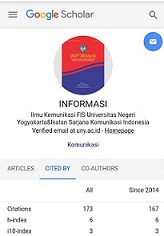The effect of network convergence on digital culture industry: Model construction of network industrial economics and empirical study on China
Anang Masduki, Department of Communication Studies, Universitas Ahmad Dahlan, Indonesia
Xigen Li, Department of Journalism and Communication, Shanghai University, China
Filosa Gita Sukmono, Department of Communication Studies, Universitas Muhammadiyah Yogyakarta, Indonesia
Abstract
This paper constructs the model of network economics to study the effect of different levels of network convergence on the digital culture industry. Then uses regression models and mediating effect models to test the effect mechanism of network convergence on the digital culture industry of China. This paper used panel data to conduct an empirical study. The data in this paper were quarterly. The time range was from the first quarter of 2009 to the third quarter of 2013 for 19 quarters.The three data types in econometrics are time series data, cross-sectional data, and panel data.The main conclusions are as follows. Network convergence brings positive policy effects and adverse capital effects. The impact of network convergence on firm performance of the digital culture industry is not statistically significant, and this effect also has no indirect effects on the test of mediating effect. However, network convergence indirectly leads to the reduction of operating costs of the digital culture industry. The indirect effect is brought by the chain mediating effect of policy effect and capital effect. The study could provide a reference for other countries and regions. Meanwhile, it can be used to analyze the impact of different media convergence on digital industries.
Keywords
Full Text:
PDFReferences
Bardhan, I., Krishnan, V., & Lin, S. (2013). Research note-business value of information technology: Testing the interaction effect of I.T. and R&D on Tobin's Q. Information Systems Research, 24 (4), 1147-1161.
Brusoni, S., & Pavitt, K. (2003). Problem solving and the co-ordination of innovative activities. The University of Sussex, SPRU Electronic Working Paper Series, 93.
Cao, S. F. (2015). The change of media industry driven by capital and policy. Science & Technology for China's Mass Media. (9),86-91.
Chen, P. (2011). Upgrading strategy for T.V. content industry in triple-play environment. TV Research, (1), 17-20.
Francis, M., Thomas, A., Thompson, G., & Rowlands, H. (September 9-11, 2009). Convergence and the digital culture industry: New business models and supply chain structures for a volatile new digital landscape. Logistics Research Network Annual Conference: Volatile and Fragile Supply Chains. Cardiff University.
Gao, C. (2014). Development of digital culture industry of China in the background of tri-network convergence. Business age, 23, 125-127.
Gao, D. (2013). Market structure and competitive behavior of digital culture industry under tri-network convergence. Master thesis of Southeast University.
Hacklin, F., Raurich, V., & Marxt, C. (2005). Implications of technological convergence on innovation trajectories: The case of the ICT industry. International Journal of Innovation and Technology Management, 2(3), 313-330.
Hu, H. (2007). Network convergence: Services, applications, transport, and operations support. Wiley.
Ioannis, M. (2009). Information, telecommunication technologies and media convergence challenges: Perspectives on the creative content industries. VUB Press.
Iosifidis, P. (2002). Digital convergence: challenges for European regulation. The public, 9(3), 27-48.
Khalil, E. L. (1993). Economic behavior and institutions. International Review of Economics & Finance, 2(4),429-432.
Kim, S. (2010). Research in convergence: A literature analysis. Journal of Research and Practice in Information Technology, 42(3), 191-205.
Lind, J. (2004). Convergence: History of term usage and lessons for firm strategists. Paper presented at the 15th Biennial ITS Conference.
Liu, C. (2013). Examining China's triple-network convergence plan: Regulatory challenges and policy recommendations. Government Information Quarterly, 30(1), 45-55.
McLuhan, M. (1964). Understanding media. Routledge.
Mi, L.J. (2015). Research review of tri-network convergence: From concept to operation. Editorial Friend, (1), 25-28.
Miyazaki, K., & Giraldo, E. (2015). Innovation strategy and technological competence building to provide next-generation network and services through convergence–the case of NTT in Japan. Asian Journal of Technology Innovation, 23 (sup1), 74-92.
Moyer, S., & Umar, A. (2001). The impact of network convergence on telecommunications software. IEEE Communications Magazine, 39 (1), 78-84.
Nabli, M. K., Nugent, J. B. (2016). The new institutional economics and its applicability to development. World Development, 17(9),1333-1347.
Napoli, P. (2001). Foundations of communications policy: Principles and process in the regulation of electronic media. Cresskill, NJ: Hampton Press.
OVUM. (1999). Fixed-mobile convergence service integration and substitution.
Patel, V. (1992). Broadhand convergence: A view of the regulatory barriers. Telecommunications Policy, 16(2), 98-104.
Qin, M. (2014). Network game: An important centre and pulling power of tri-network convergence. Beauty and Times (Early), (7), 56-59.
Rong, H. (2014). Learning from foreign experience to push tri-network convergence of China. Private Science and Technology, (11), 224.
Rost, P., Boutaba, R., Doppler, K,, & Gumaste, A. (2011). Recent advances in networks convergence. Computer Networks, Computer Networks, 55 (7), 1455-1458.
Shy, O. (2001). The economics of network industries, Cambridge University Press.
Song, D. (2014). Copyright protection strategies of digital music in tri-network convergence context. Publishing Research, (3), 61-63.
Stock, J. H., & Watson, M. W. (2003). Instructional stata datasets for econometrics. Boston College Department of Economics.
Tang, X. D., & Xiao, Y. F. (2013). Transition and upgrade of digital publishing in the tri-network convergence era. Press Circles, (4), 72-75.
The State Council. (February 20, 2010). The state council confirms the paths and schedule of tri-network convergence. Beijing Daily.
Tsai, H. H., Lee, H. Y., & Yu, H. C. (2008). Developing the digital culture industry in Taiwan. Review of Policy Research, 25(2), 169-188.
Tu, W. Y. (September 18, 2012). Triple play is in full swing, and the content industry is the most impressive. Communication world weekly.
Whitt, R. S. (2004). A horizontal leap forward: Formulating a new communications public policy framework based on the network layers model. Federal Communications Law Journal, 56(3), 587.
Wu, R. W., & Leung, G. K. (2012) Implementation of three network convergence in China: A new institutional analysis. Telecommunications Policy, 36(10-11), 955-965.
Wurgler, J. (2001). Financial market and the allocation of capital. Journal of Financial Economics, 58 (1), 187-214.
Yang, J. (2011). Study on venture capital and the development of digital publishing Industry. Peking University Master's Thesis.
Yong, G. J., & So, Y. S. (2008). Structural equation model for effective CRM of digital culture industry. Expert Systems with Applications, 34 (1), 63-71.
DOI: https://doi.org/10.21831/informasi.v51i2.44986
Refbacks
- There are currently no refbacks.
Copyright (c) 2022 Panqiang Niu, Anang Masduki, Xigen Li, Filosa Gita Sukmono
Supervised by
Our Journal has been Indexed by:
Informasi by http://journal.uny.ac.id/index.php/informasi is licensed under a Creative Commons Attribution-NonCommercial 4.0 International License.















